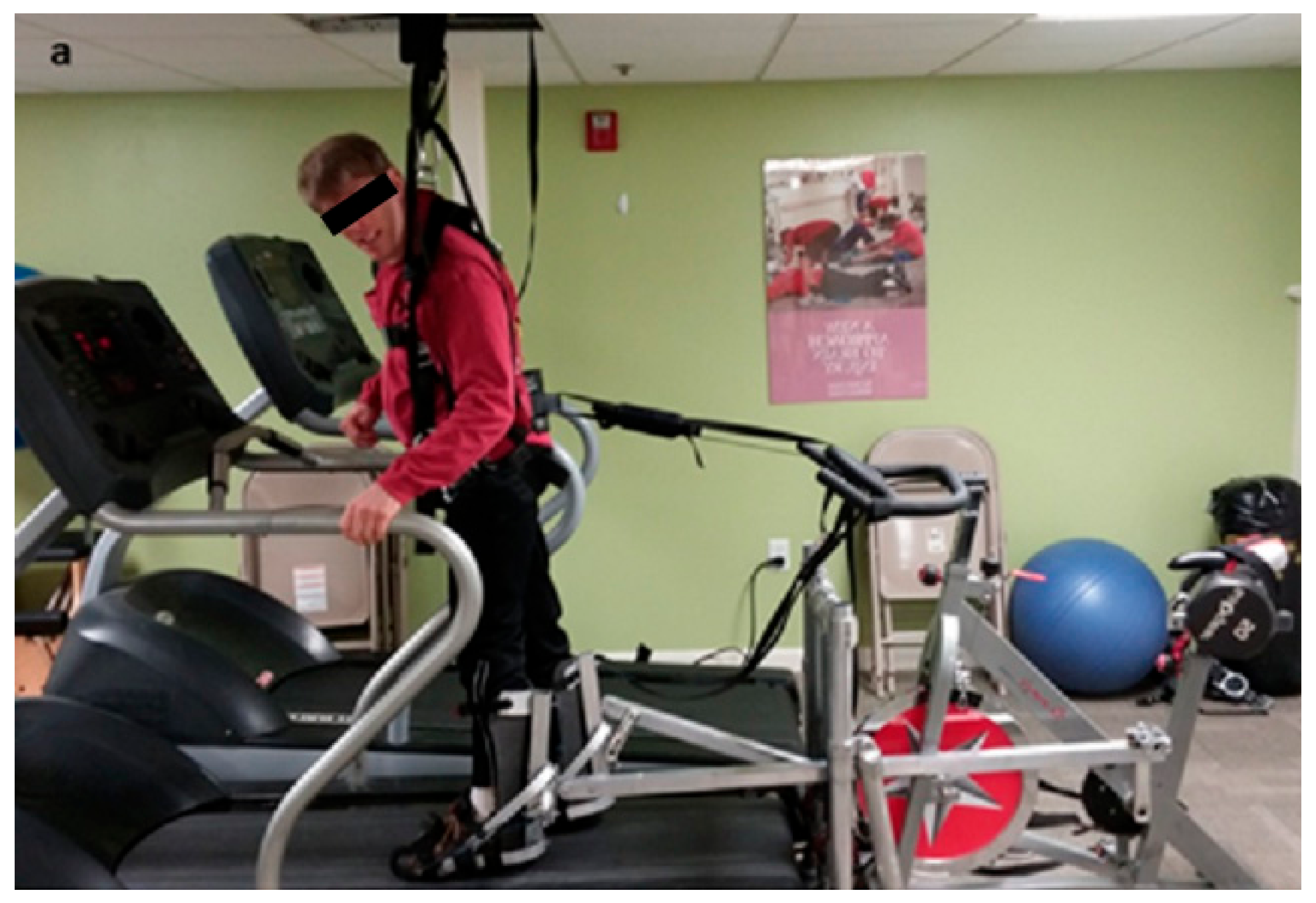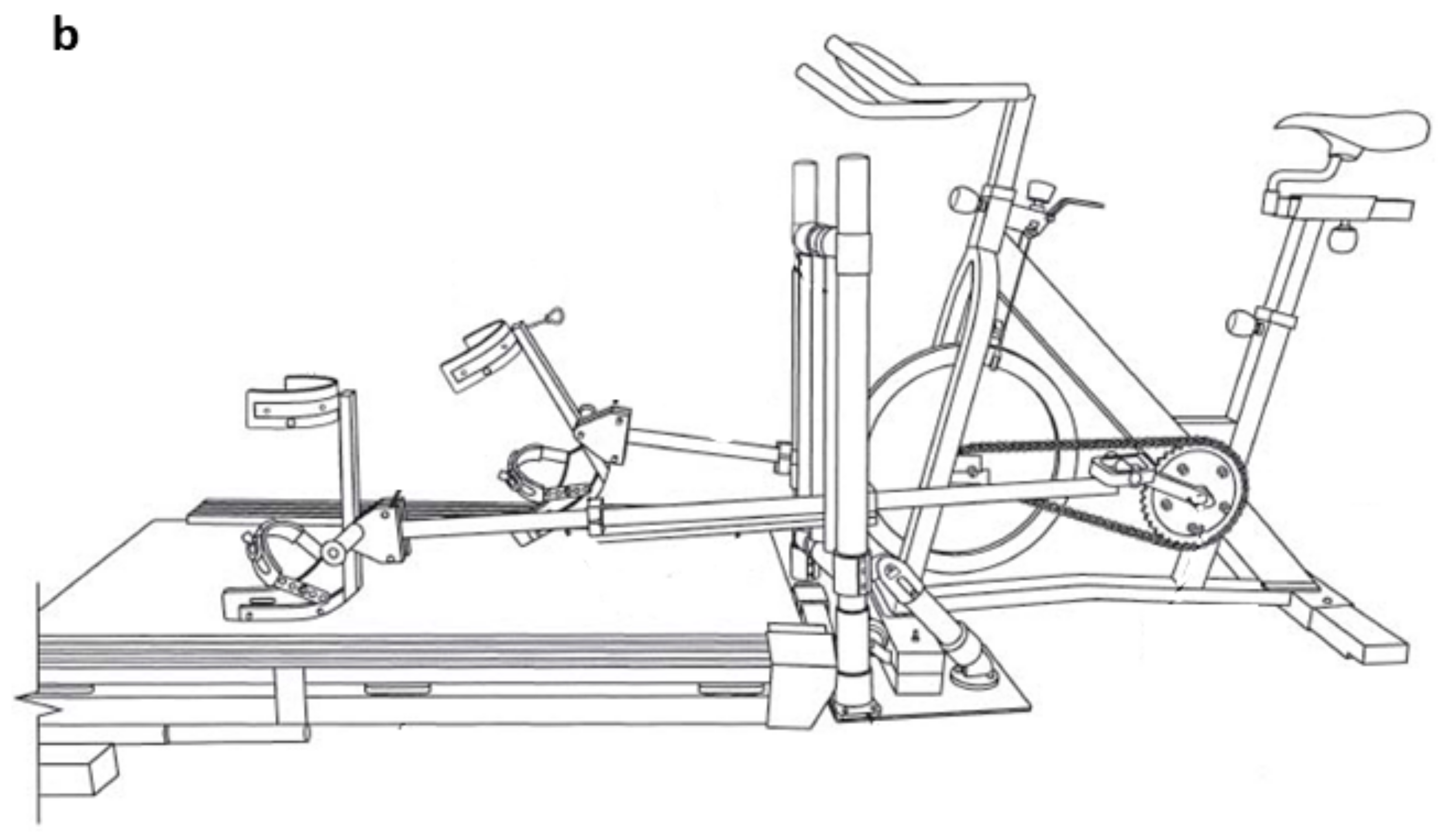The Effect of a Low-Cost Body Weight-Supported Treadmill Trainer on Walking Speed and Joint Motion
Abstract
1. Introduction
2. Materials and Methods
2.1. Participants
2.2. Intervention
2.3. Gait Analysis
2.4. Data Analysis
3. Results
4. Discussion
5. Conclusions
Author Contributions
Funding
Acknowledgments
Conflicts of Interest
References
- Disabled World. Disability Statistics: Information, Charts, Graphs and Tables. Available online: https://www.disabled-world.com/disability/statistics/ (accessed on 28 July 2019).
- Middleton, A.; Fritz, S.L.; Lusardi, M. Walking speed: The functional vital sign. J. Aging Phys. Act. 2015, 23, 314–322. [Google Scholar] [CrossRef] [PubMed]
- Pirpiris, M.; Wilkinson, A.J.; Rodda, J.; Nguyen, T.C.; Baker, R.J.; Nattrass, G.R.; Graham, H.K. Walking speed in children and young adults with neuromuscular disease: Comparison between two assessment methods. J. Pediatr. Orthop. 2003, 23, 302–307. [Google Scholar] [CrossRef] [PubMed]
- Eng, J.J.; Dawson, A.S.; Chu, K.S. Submaximal exercise in persons with stroke: Test-retest reliability and concurrent validity with maximal oxygen consumption1. Arch. Phys. Med. Rehabil. 2004, 85, 113–118. [Google Scholar] [CrossRef]
- Schmid, A.; Duncan, P.W.; Studenski, S.; Lai, S.M.; Richards, L.; Perera, S.; Wu, S.S. Improvements in speed-based gait classifications are meaningful. Stroke 2007, 38, 2096–2100. [Google Scholar] [CrossRef] [PubMed]
- Scivoletto, G.; Tamburella, F.; Laurenza, L.; Foti, C.; Ditunno, J.F.; Molinari, M. Validity and reliability of the 10-m walk test and the 6-min walk test in spinal cord injury patients. Spinal Cord 2011, 49, 736. [Google Scholar] [CrossRef] [PubMed]
- Esquenazi, A.; Lee, S.; Wikoff, A.; Packel, A.; Toczylowski, T.; Feeley, J. A Comparison of locomotor therapy interventions: Partial-body weight-supported treadmill, Lokomat, and G-EO Training in people with traumatic brain injury. PM&R 2017, 9, 839–846. [Google Scholar] [CrossRef]
- Husemann, B.; Müller, F.; Krewer, C.; Heller, S.; Koenig, E. Effects of locomotion training with assistance of a robot-driven gait orthosis in hemiparetic patients after stroke. Stroke 2007, 38, 349–354. [Google Scholar] [CrossRef] [PubMed]
- Van Nunen, M.P.M.; Gerrits, K.H.L.; Konijnenbelt, M.; Janssen, T.W.J. Recovery of walking ability using a robotic device in subacute stroke patients: A randomized controlled study. Disabil. Rehabil. Assist. Technol. 2015, 10, 141–148. [Google Scholar] [CrossRef] [PubMed]
- Mehrholz, J.; Elsner, B.; Werner, C.; Kugler, J.; Pohl, M. Electromechanical-assisted training for walking after stroke-Cochrane review. Cochrane Database Syst. Rev. 2013, 7. [Google Scholar] [CrossRef]
- Tomelleri, C.; Waldner, A.; Hesse, S. EMG analysis methods on robotic gait machines. In Applications of EMG in Clinical and Sports Medicine; Steele, C., Ed.; Intechopen: Rijeka, Croatia, 2012. [Google Scholar]
- Jezernik, S.; Colombo, G.; Keller, T.; Frueh, H.; Morari, M. Robotic orthosis Lokomat: A rehabilitation and research tool. Neuromodulation 2003, 6, 108–115. [Google Scholar] [CrossRef] [PubMed]
- Lokomat Technical Data Sheet. Hocoma AG: Volketswil., Switzerland: 2019. Available online: https://www.hocoma.com/solutions/lokomat/techincal-data-sheet (accessed on 28 February 2019).
- Henning, S.; Hesse, S.; Bernhardt, R.; Krüger, J. HapticWalker: A novel haptic foot device. ACM Trans. Appl. Percept. 2005, 2, 166–180. [Google Scholar] [CrossRef]
- Chau, J. Cost Effectiveness of an electromechanical gait trainer for ambulation training after stroke in a singaporean community hospital: A single blind randomised trial. Phys. Med. Rehabil. Int. 2016, 3, 1102. [Google Scholar]
- Lilley, R.W. Gait Pattern Training Device. U.S. Patent Application 20170281999A1, 5 October 2017. [Google Scholar]
- Gait Trainer Program. AccesSportArmerica: Acton, MA, USA. Available online: http://www.accessportamerica.org/gait-trainer-program (accessed on 28 February 2019).
- Wolf, S.L.; Catlin, P.A.; Gage, K.; Gurucharri, K.; Robertson, R.; Stephen, K. Establishing the reliability and validity of measurements of walking time using the Emory Functional Ambulation Profile. Phys. Ther. 1999, 79, 1122–1133. [Google Scholar] [PubMed]
- Watson, M.J. Refining the ten-metre walking test for use with neurologically impaired people. Physiotherapy 2002, 88, 386–397. [Google Scholar] [CrossRef]
- Whittle, M.W. Gait Analysis: An Introduction, 4th ed.; Butterworth-Heinemann: New York, NY, USA, 2007; p. 244. [Google Scholar]
- Page, P. Beyond statistical significance: Clinical interpretation of rehabilitation research literature. Int. J. Sports Phys. Ther. 2014, 9, 726–736. [Google Scholar] [PubMed]
- Perera, S.; Mody, S.H.; Woodman, R.C.; Studenski, S.A. Meaningful change and responsiveness in common physical performance measures in older adults. J. Am. Geriatr. Soc. 2006, 54, 743–749. [Google Scholar] [CrossRef] [PubMed]
- Perry, J.; Garrett, M.; Gronley, J.K.; Mulroy, S.J. Classification of walking handicap in the stroke population. Stroke 1995, 26, 982–989. [Google Scholar] [CrossRef] [PubMed]
- Jonkers, I.; Delp, S.; Patten, C. Capacity to increase walking speed is limited by impaired hip and ankle power generation in lower functioning persons post-stroke. Gait Posture 2009, 29, 129–137. [Google Scholar] [CrossRef] [PubMed]
- Ellapen, T.J.; Hammillm, H.V.; Swanepoel, M.; Strydom, G.L. The health benefits and constraints of exercise therapy for wheelchair users: A clinical commentary. Afr. J. Disabil. 2017, 6, 337. [Google Scholar] [CrossRef] [PubMed]
- Carver, D.J.; Chapman, C.A.; Thomas, V.S.; Stadnyk, K.J.; Rockwood, K. Validity and reliability of the Medical Outcomes Study Short Form-20 questionnaire as a measure of quality of life in elderly people living at home. Age Ageing 1999, 28, 169–174. [Google Scholar] [CrossRef] [PubMed]


| Partic. | Diagnosis | Training | 10MWT | Affected Leg | Unaffected Leg | |||||||||
|---|---|---|---|---|---|---|---|---|---|---|---|---|---|---|
| Weeks | Sessions | Time, min | Velocity, m/s | Step Length, m | Step Time, s | Step Length, m | Step Time, s | |||||||
| Pre | Post | Pre | Post | Pre | Post | Pre | Post | Pre | Post | |||||
| 1 | Stroke | 40 | 50 | 31 | 0.23 | 0.31 | 0.54 | 0.64 | 0.63 | 0.62 | 0.64 | 0.58 | 1.03 | 0.97 |
| 2 | TBI | 30 | 23 | 39 | 0.25 | 0.36 | 0.37 | 0.42 | 2.00 | 1.50 | 0.43 | 0.48 | 0.97 | 0.87 |
| 3 | TBI | 34 | 71 | 43 | 0.29 | 0.54 | 0.42 | 0.38 | 3.00 | 1.83 | 0.44 | 0.43 | 1.43 | 1.07 |
| 4 | Stroke | 29 | 27 | 31 | 0.30 | 0.39 | 0.38 | 0.48 | 1.37 | 1.00 | 0.30 | 0.39 | 1.03 | 0.70 |
| 5 | CP | 35 | 70 | 42 | 0.33 | 0.56 | 0.56 | 0.47 | 1.07 | 0.77 | 0.50 | 0.56 | 1.40 | 1.07 |
| 6 | Stroke | 28 | 20 | 33 | 0.50 | 0.88 | 0.42 | 0.58 | 0.73 | 0.67 | 0.34 | 0.72 | 0.93 | 0.83 |
| 7 | Stroke | 17 | 17 | 35 | 0.58 | 0.65 | 0.41 | 0.53 | 0.87 | 0.77 | 0.44 | 0.53 | 0.70 | 0.60 |
| 8 | TBI | 16 | 18 | 28 | 0.95 | 1.34 | 0.48 | 0.47 | 0.47 | 0.33 | 0.41 | 0.42 | 0.83 | 0.33 |
| 9 | Stroke | 12 | 12 | 25 | 1.13 | 1.15 | 0.73 | 0.69 | 0.63 | 0.63 | 0.55 | 0.52 | 0.53 | 0.53 |
| 10 | Stroke | 35 | 56 | 41 | 1.29 | 1.89 | 0.67 | 0.85 | 0.40 | 0.37 | 0.51 | 0.71 | 0.60 | 0.43 |
| 11 | Stroke | 35 | 42 | 32 | 1.33 | 1.15 | 0.68 | 0.82 | 0.47 | 0.50 | 0.73 | 0.81 | 0.77 | 0.77 |
| Mean | 29.8 | 36.9 | 34.5 | 0.65 | 0.84 | 0.51 | 0.58 | 1.06 | 0.82 | 0.48 | 0.56 | 0.93 | 0.74 | |
| SD | 8.9 | 21.8 | 6.0 | 0.44 | 0.50 | 0.13 | 0.16 | 0.80 | 0.47 | 0.13 | 0.14 | 0.29 | 0.25 | |
| p-value | 0.016 | 0.052 - | 0.011 0.37 | 0.059 - | 0.004 0.67 | |||||||||
| Cohen’s d | 0.40 | |||||||||||||
| Partic. | Affected | Walking | Ankle DF | Ankle PF | Knee Flexion | Hip Extension | Hip Flexion | |||||
|---|---|---|---|---|---|---|---|---|---|---|---|---|
| Side | Aide | Pre | Post | Pre | Post | Pre | Post | Pre | Post | Pre | Post | |
| 1 | right | assisted | 6 | 7 | 8 | 6 | 42 | 46 | 25 | 31 | 18 | 36 |
| 2 | left | assisted | 9 | −7 | −34 | −26 | 44 | 33 | 25 | 27 | 40 | 39 |
| 3 | left | assisted/AFO | −9 | −4 | −36 | 14 | 30 | 13 | −2 | 7 | 19 | 8 |
| 4 | right | cane/AFO | −16 | −15 | −39 | −30 | 19 | 14 | 2 | 2 | 4 | 16 |
| 5 | left | assisted/biAFO | 2 | 7 | −18 | −8 | 44 | 47 | −3 | −6 | 8 | 15 |
| 6 | right | none | 5 | 12 | −10 | −18 | 48 | 38 | 5 | −4 | 30 | 30 |
| 7 | right | none | 5 | −2 | −9 | −9 | 42 | 39 | 4 | −3 | 17 | 23 |
| 8 | right | biAFO | 11 | −4 | 6 | −9 | 33 | 28 | 7 | −8 | 19 | 22 |
| 9 | right | AFO | −4 | 5 | −26 | −21 | 13 | 21 | −13 | 2 | 27 | 22 |
| 10 | left | AFO | 22 | 1 | −26 | −10 | 29 | 18 | −19 | −13 | −6 | 17 |
| 11 | right | AFO | −3 | −11 | −23 | −28 | 35 | 30 | −16 | −17 | 20 | 16 |
| Mean | 0.3 | −1.5 | −18.1 | −12.1 | 34.3 | 29.9 | 1.5 | 5.2 | 18.7 | 21.1 | ||
| SD | 9.1 | 8.4 | 15.9 | 13.1 | 11.4 | 12.8 | 14.5 | 13.9 | 10.7 | 10.3 | ||
| p-value | 0.297 | 0.268 | 0.059 | 0.477 | 0.195 | |||||||
© 2019 by the authors. Licensee MDPI, Basel, Switzerland. This article is an open access article distributed under the terms and conditions of the Creative Commons Attribution (CC BY) license (http://creativecommons.org/licenses/by/4.0/).
Share and Cite
Ventura, J.D.; Charrette, A.L.; Roberts, K.J. The Effect of a Low-Cost Body Weight-Supported Treadmill Trainer on Walking Speed and Joint Motion. Medicina 2019, 55, 420. https://doi.org/10.3390/medicina55080420
Ventura JD, Charrette AL, Roberts KJ. The Effect of a Low-Cost Body Weight-Supported Treadmill Trainer on Walking Speed and Joint Motion. Medicina. 2019; 55(8):420. https://doi.org/10.3390/medicina55080420
Chicago/Turabian StyleVentura, Jessica D., Ann L. Charrette, and Katherine J. Roberts. 2019. "The Effect of a Low-Cost Body Weight-Supported Treadmill Trainer on Walking Speed and Joint Motion" Medicina 55, no. 8: 420. https://doi.org/10.3390/medicina55080420
APA StyleVentura, J. D., Charrette, A. L., & Roberts, K. J. (2019). The Effect of a Low-Cost Body Weight-Supported Treadmill Trainer on Walking Speed and Joint Motion. Medicina, 55(8), 420. https://doi.org/10.3390/medicina55080420




